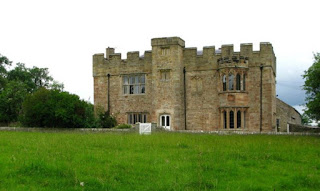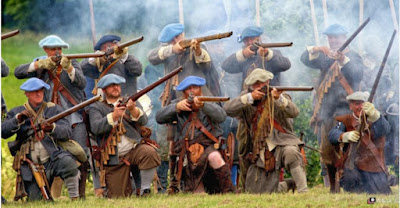In Kirklington, George feared he was a wanted man and he lay low for a while. His sympathies were with the King, but he reckoned the King's cause was lost, and what would be achieved by involving himself in utter ruin? So he didn't attempt to go west to join Royalist forces. He thought it would be prudent for his family if they just stayed quiet.
But the following month, the Wandesfords unintentionally attracted unwanted attention.
Firstly, on 19 August 1644, Mr Dagget, the kindly Rector of Kirklington, died. The Wandesfords had always been entitled in law to appoint the next Rector and their choice was Mr Michael Syddall. They knew about him because he was married to Ellen Hunton, the widow of the late Mr Wandesford's steward, and he was a man of their own views in religion. They had very much appreciated the sermon he had preached at Mr Dagget's funeral.
But the decision was now Parliament's, and Mrs Wandesford's attempt to get the help of Sir Thomas Fairfax, a friend in happier days, did not succeed. A Mr Clarkson was sent to Kirklington instead. The congregation took badly to him, especially when he preached against the Lord's Prayer – he was a severe Puritan who believed that it was a pattern for heartfelt prayer, that simply reciting it was Popery and so those who did so would be damned. The people booed and hissed him out of the church and another minister to the liking of Parliament, one Mr Philip Nesbit, was sent instead.
Now he was twenty-one, George was obliged by Act of Parliament to sign the Solemn League and Covenant made between the English Parliament and the Scottish Covenanters. George didn't back down from his principles and he refused, because signing it went against his religious beliefs and against his loyalty to the King. There wasn't a penalty in law for refusing, though Alice says that the Scottish armies stationed in Richmondshire were forcing men to sign under pain of imprisonment or ruin, but the names of men who refused were notified to Parliament. So although George had tried not to attract attention, it might have been this refusal that got him denounced as a Malignant – a traitor to the Parliament.
Then George was accused of having taken part in the Battle of Marston Moor. Two men who had recognised him on the moor were called to York to give evidence against him, but though they wouldn't say that they had seen him engaged in the fighting, and though he was still under age at the time, he was declared a Delinquent and his estates were confiscated from him by the Sequestration Committee. Alice always thought it was done through some sinister machinations by Mr Nesbit as a way to get himself appointed minister to the choice living of Kirklington, where he announced the sequestration of George's estates in a triumphing manner in the pulpit.
So the family went to live at Hipswell, which belonged to Mrs Wandesford under the terms of her marriage settlement. This had the consolation that they were now near to Mr Michael Syddall, who had been their choice of minister for Kirklington and who was now vicar of Catterick. And so they were still able to pray the Lord's Prayer and take Holy Communion, which disappeared in many places because it was contrary to Puritan beliefs, and Mr Syddall was to take baptisms and burials for the family in the years to come.
 |
| Hipswell Hall. [By David Rogers CC BY-SA 2.0] |
Scots soldiers at Hipswell & other perils
Unfortunately, Hipswell was much nearer to Richmond, and the town was now garrisoned by the Allies – the castle had been partly in ruins for a hundred years – and Scottish soldiers were everywhere. And they were billeted on the locals. Both armies always saved money by doing this because it meant the troops were kept at the civilians' expense. This was a nuisance and a burden to everybody, but especially distressing if the householder had supported the other side.
For the next year and a half, Mrs Wandesford was burdened sometimes by Scots soldiers and sometimes by Parliamentarians. She was very short of funds and she had to borrow to cover the cost of keeping her own family, making her monthly payment to the Allies and paying for the upkeep of a troop of Scots horse.
She wasn't only bothered by worries over money – she also had to keep her pretty 19 year old daughter safe. So she never allowed the captains and commanders to live in the house with the family. At last there came one Captain Innes, who commanded a troop stationed at Richmond.
One day, he walked unexpectedly into the house. Alice was in her mother's chamber when he walked boldly into the room to see Mrs Wandesford, and she had no chance to hide before he saw her. When he did, he became very determined to stay in the house, promising he would keep to his own quarters out of their way ... Finally they managed to get rid of him. All the while Alice was in a tremble of fear because he looked so wild and bloody looking a man and he reminded her of the rebel lords in Ireland.
Captain Innes went back to Richmond and he told Alice's aunt Mrs Norton that he would give all he was worth if she would procure Alice to be his wife, offering £4,000 and saying that his colonel Lord Adair would come with him to speak for him. Mrs Norton replied that Alice was not to be obtained by him and that she was sure that Alice had given him no encouragement, because she was resolved not to marry. Then she sent a private message to Alice to warn her that the men were coming and that she should get out of his way.
Mrs Wandesford was horrified. She was afraid that they would burn the house down and she sent Alice out of the house to find somewhere to hide. Very frightened, Alice ran into Richmond and hid herself with a good old woman who was one of the Wandesfords' tenants. When night came and she could be sure that the men's visit was over, she went home. All the while, Mrs Wandesford had been trying to placate them by bringing out the best of her provisions, assuring them that she had no idea where Alice was, and sending servants out to look for her. Captain Innes was enraged.
At about this time her mother wasn't very well, and so Alice had been sitting up a good deal with her and writing letters for her. Becoming anxious for Alice's own health, Mrs Wandesford used to send her out in the company of her maids to get some fresh air. So Alice would take a walk out to Lows – probably low-lying pasture land – and come back refreshed. One day she was stopped by one of the Scots soldiers. He didn't want to alarm her too much but he had an urgent warning for her:
Dear mistress, I pray do not think much if I desire you, for God's sake, not to go out with the maids to Lows.
Alice knew the man – she had treated his hand when it had been badly cut. He had come to return the favour. He warned her that Captain Innes, cursing and swearing, planned that very night to come with a great number of men and catch her and take her away by force. Deeply grateful for this rescue from rape and ruin, she gave the man many thanks and rewarded him for his trouble. And after that she stayed at home like a prisoner, waiting for Captain Innes to leave Richmondshire.
In June 1645, when the time came for the Scots troops to go, some marching south to Doncaster and others leaving for Scotland to fight against the Scottish Royalists, Captain Innes sent – in a boasting manner, Alice said – to Mrs Wandesford for his pay. She sent him all that she owed him, but he wouldn't take it. He demanded double. She wouldn't pay. So one Sunday morning he arrived with his company at Hipswell, threatening to break down the doors of the Hall, and sending his men to drive off Mrs Wandesford's cattle. As he swore and raged, Alice went up onto the leads – the roof – to see what was happening to the cattle. Looking up, he mistook her for her mother and he cursed her bitterly, wishing that the Devil would blow her blind and into the air. She had been a thorn in his heel, but he would be a thorn in her side. And so his men drove off the cattle – a delicate breed of Mrs Wandesford's own – to Richmond.
Mrs Wandesford took the pay that she owed him and set off for Richmond herself. She went to St Nicholas, the house of her sister-in-law Mrs Norton, where she could find the Scottish commander, General David Leslie. When she told him the story, he took the money and said he would make Captain Innes accept it. When Captain Innes left for Scotland he swore that, if the Scots returned, they would burn both the women and all they had.
 |
| Sir David Leslie (1600-82) |
And besides these dangers, there were natural perils.
The bubonic plague was close at hand. In November 1644, it broke out in Richmond and it lasted a year. About 700 people died. Unnecessary gatherings and visits to other people's houses were banned, and in muddy and damp weather the people were told to keep their doors and windows shut. People left the town if they could. Hipswell escaped the infection, and every day Mrs Wandesford gave out food and money to beggars whose livelihoods had been lost in the outbreak.
At this time, after the Battle of Marston Moor and the defeat of the Royalists in the North, Alice's sister Catherine and her family were living at Middleham Castle under the protection of Edward, Lord Loftus.
Sir Thomas was there too, as Alice remembered. He had commanded a Mashamshire regiment for the King and must have been taken by the Parliamentarians at Marston Moor because it is said that he was imprisoned for a long while. Lord Loftus, on the other hand, was a Parliamentarian. Sir Thomas will have known Lord Loftus and his family not only as neighbours but also from his own brief time in Dublin – Loftus's father was Adam Loftus, who had been Lord Chancellor of Ireland until his career was destroyed and he was ruined by Strafford. Then he had returned to his small property at Coverham and Edward, who had been imprisoned by Strafford for a short while, married the heiress to nearby Middleham and its castle. Perhaps Sir Thomas and Lord Loftus had always been personal friends – or perhaps it was simply that Loftus was extending a courtesy to a fellow member of the local gentry – and of course Catherine would be a welcome guest as the daughter of a man who didn't make enemies, unlike his friend Strafford – at any rate, there they were, safe inside a castle that Lord Loftus was garrisoning for Parliament at his own expense. And there she had another baby.
 |
| Middleham Castle |
NoteAlice refers to the "river near Midlam, called Swale" – which is a tributary of the Ure. But it must have been the Ure that she needed to cross because that's the river at Middleham.






















